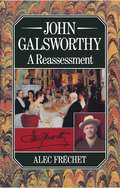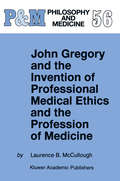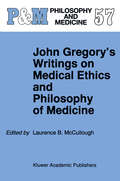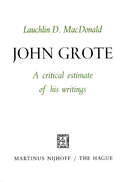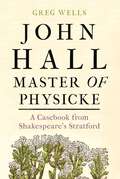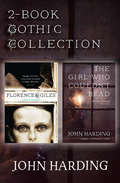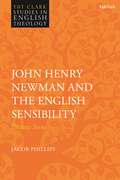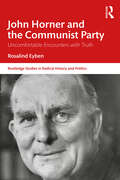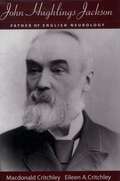- Table View
- List View
John Frederick Oberlin/h
by John W. KurtzThis book covers the life of John Frederic Oberlin from his adolescence to his death. It provides adequate details of the relationships between Oberlin's life and work and the social and intellectual currents of his time, with impartiality and rational perspective.
John Gregory and the Invention of Professional Medical Ethics and the Profession of Medicine (Philosophy and Medicine #56)
by Laurence B. McCulloughThe best things in my Ufe have come to me by accident and this book results from one such accident: my having the opportunity, out of the blue, to go to work as H. Tristram Engelhardt, Jr. 's, research assistant at the Institute for the Medical Humanities in the University of Texas Medi cal Branch at Galveston, Texas, in 1974, on the recommendation of our teacher at the University of Texas at Austin, Irwin C. Lieb. During that summer Tris "lent" me to Chester Bums, who has done important schol arly work over the years on the history of medical ethics. I was just finding out what bioethics was and Chester sent me to the rare book room of the Medical Branch Library to do some work on something called "medical deontology. " I discovered that this new field of bioethics had a history. This string of accidents continued, in 1975, when Warren Reich (who in 1979 made the excellent decisions to hire me to the faculty in bioethics at the Georgetown University School of Medicine and to persuade Andre Hellegers to appoint me to the Kennedy Institute of Ethics) took Tris Engelhardt's word for it that I could write on the history of modem medical ethics for Warren's major new project, the Encyclopedia of Bioethics. Warren then asked me to write on eighteenth-century British medical ethics.
John Gregory's Writings on Medical Ethics and Philosophy of Medicine (Philosophy and Medicine #57)
by John Gregory Laurence B. McCulloughThis volume introduces a new subseries of Philosophy and Medicine, Classics of Medical Ethics. The purpose of this new subseries is to bring out scholars' editions of major works in the history of medical ethics and philosophy of medicine. This new subseries will target for publication texts that are long out of print and difficult to access. Each volume will contain an introduction to the writings on medical ethics and philosophy of medicine produced by the original author. Each volume will also contain a guide to the primary and major secondary Hterature, to facilitate teaching and scholarship in bioethics, philosophy of medicine, and history of medicine. Texts will be presented in their origi nal style and will provide pagination of the original, so that citations can be made either to the original text or to the page numbers in these vol umes. Finally, each volume will be well indexed, again to facilitate teaching and research. Bioethics and philosophy of medicine - the former more so than the latter - have an insufficiently developed understanding of themselves as having a history. As a consequence, these fields lack the maturity that critical dialogue of the past with the present provides for other fields and disciplines of the humanities. To the extent that this problem is due to the fact that major primary historical sources are not readily available, this subseries will contribute to the further development and maturation of bioethics and philosophy of medicine as fields of the humanities.
John Grote: A Critical Estimate of his Writings
by Lauchlin D. MacDonaldAn objective of this book is to discuss some of the contributions made by John Grote to philosophy. This work is an extension of a dissertation written for the doctorate at Boston University. The author wishes to acknowledge the invaluable assistance in many places to Professor Peter A. Bertocci and the late Professor Edgar S. Brightman both of whom read the entire manuscript in its original form. Also, the author acknowledges the encouraging interest and support of his wife, Helen, whose many suggestions have improved the writing and without whose assistance this work would not have been accomplished. The author assumes complete responsibility for whatever errors or deficiencies appear in the book. All known writings of Grote are listed and the more important ones analyzed. LAUCHLIN D. MACDONALD CHAPTER I INTRODUCTION 1. JOHN GROTE'S LIFE i. Sketch of his life John Grote will remain best known by reason of the thought formu lated in the Exploratio Philosophica, or Rough Notes on Modern I ntellectu al Science. To the philosophical world of his own time he was well known as the teacher who ably held the chair of Moral Philosophy in the University of Cambridge from r855 until the year of his death, r866, to the Knightbridge Professor, William Whewell whose in succession Philosophy of Science is the subject of at least one chapter of the Exploratio Philosophica. Grote's birthplace was Beckenham in Kent, and the date, May 5, r8r3.
John Hall, Master of Physicke: A casebook from Shakespeare's Stratford
by Paul Edmondson Greg WellsThis is the first complete edition and English translation of John Hall’s Little Book of Cures, a fascinating medical casebook composed in Latin around 1634–5. John Hall (1575–1635) was Shakespeare’s son-in-law (Hall married Susanna Shakespeare in 1607), and based his medical practice in Stratford-upon-Avon. Readers have never before had access to a complete English translation of John Hall’s casebook, which contains fascinating details about his treatment of patients in and around Stratford. Until Wells’s edition, our knowledge of Hall and his practice has had to rely only on a partial, seventeenth-century edition (produced by James Cooke in 1657 and 1679, and re-printed with annotation by Joan Lane as recently as 1996). Cooke’s edition significantly misrepresents Hall by abridging his manuscript (Cooke removed Hall’s conversations with his patients), by errors of translation, and by combining Hall’s work with examples from Cooke’s own medical practice.
John Hall, Master of Physicke: A casebook from Shakespeare's Stratford
by Greg Wells Paul EdmondsonThis is the first complete edition and English translation of John Hall’s Little Book of Cures, a fascinating medical casebook composed in Latin around 1634–5. John Hall (1575–1635) was Shakespeare’s son-in-law (Hall married Susanna Shakespeare in 1607), and based his medical practice in Stratford-upon-Avon. Readers have never before had access to a complete English translation of John Hall’s casebook, which contains fascinating details about his treatment of patients in and around Stratford. Until Wells’s edition, our knowledge of Hall and his practice has had to rely only on a partial, seventeenth-century edition (produced by James Cooke in 1657 and 1679, and re-printed with annotation by Joan Lane as recently as 1996). Cooke’s edition significantly misrepresents Hall by abridging his manuscript (Cooke removed Hall’s conversations with his patients), by errors of translation, and by combining Hall’s work with examples from Cooke’s own medical practice.
John Harding 2-Book Gothic Collection
by John HardingA unique chance to read these two chilling Gothic tales from the brilliant storyteller John Harding together. Modern Gothic classic Florence & Giles and it’s sequel The Girl Who Couldn’t Read are a must for fans of Edgar Allen Poe.
John Hawkwood: An English Mercenary in Fourteenth-Century Italy
by William CaferroWinner, 2008 Otto Gründler Book Prize, The Medieval InstituteNotorious for his cleverness and daring, John Hawkwood was the most feared mercenary in early Renaissance Italy. Born in England, Hawkwood began his career in France during the Hundred Years' War and crossed into Italy with the famed White Company in 1361. From that time until his death in 1394, Hawkwood fought throughout the peninsula as a captain of armies in times of war and as a commander of marauding bands during times of peace. He achieved international fame, and city-states constantly tried to outbid each other for his services, for which he received money, land, and, in the case of Florence, citizenship—a most unusual honor for an Englishman. When Hawkwood died, the Florentines buried him with great ceremony in their cathedral, an honor denied their greatest poet, Dante. William Caferro's ambitious account of Hawkwood is both a biography and a study of warfare and statecraft. Caferro has mined more than twenty archives in Britain and Italy, creating an authoritative portrait of Hawkwood as an extraordinary military leader, if not always an admirable human being.
John Heartfield and the Agitated Image: Photography, Persuasion, and the Rise of Avant-Garde Photomontage
by Andrés Mario ZervigónWorking in Germany between the two world wars, John Heartfield (born Helmut Herzfeld, 1891–1968) developed an innovative method of appropriating and reusing photographs to powerful political effect. As a pioneer of modern photomontage, he sliced up mass media photos with his iconic scissors and then reassembled the fragments into compositions that utterly transformed the meaning of the originals. In John Heartfield and the Agitated Image, Andrés Mario Zervigón explores this crucial period in the life and work of a brilliant, radical artist whose desire to disclose the truth obscured by the mainstream press and imperial propaganda made him a de facto prosecutor of Germany’s visual culture. Zervigón charts the evolution of Heartfield’s photomontage from an act of antiwar resistance into a formalized and widely disseminated political art in the Weimar Republic. Appearing on everything from campaign posters to book covers, the photomonteur’s notorious pictures challenged well-worn assumption and correspondingly walked a dangerous tightrope over the political, social, and cultural cauldron that was interwar Germany. Zervigón explains how Heartfield’s engagement with montage arose from a broadly-shared dissatisfaction with photography’s capacity to represent the modern world. The result was likely the most important combination of avant-garde art and politics in the twentieth century. A rare look at Heartfield’s early and middle years as an artist and designer, this book provides a new understanding of photography’s role at this critical juncture in history.
John Heartfield and the Agitated Image: Photography, Persuasion, and the Rise of Avant-Garde Photomontage
by Andrés Mario ZervigónWorking in Germany between the two world wars, John Heartfield (born Helmut Herzfeld, 1891–1968) developed an innovative method of appropriating and reusing photographs to powerful political effect. As a pioneer of modern photomontage, he sliced up mass media photos with his iconic scissors and then reassembled the fragments into compositions that utterly transformed the meaning of the originals. In John Heartfield and the Agitated Image, Andrés Mario Zervigón explores this crucial period in the life and work of a brilliant, radical artist whose desire to disclose the truth obscured by the mainstream press and imperial propaganda made him a de facto prosecutor of Germany’s visual culture. Zervigón charts the evolution of Heartfield’s photomontage from an act of antiwar resistance into a formalized and widely disseminated political art in the Weimar Republic. Appearing on everything from campaign posters to book covers, the photomonteur’s notorious pictures challenged well-worn assumption and correspondingly walked a dangerous tightrope over the political, social, and cultural cauldron that was interwar Germany. Zervigón explains how Heartfield’s engagement with montage arose from a broadly-shared dissatisfaction with photography’s capacity to represent the modern world. The result was likely the most important combination of avant-garde art and politics in the twentieth century. A rare look at Heartfield’s early and middle years as an artist and designer, this book provides a new understanding of photography’s role at this critical juncture in history.
John Henry Newman and the English Sensibility: Distant Scene (T&T Clark Studies in English Theology)
by Jacob PhillipsAsides about John Henry Newman being either particularly English or particularly un-English are common. John Henry Newman and the English Sensibility scrutinises Newman's theological writings to establish how his theology can be considered distinctively English or un-English at the different stages of its development. In his Tractarian period, Newman's theology is shown to be profoundly characterised by common 19th-century tropes of a perceived English sensibility, namely an instinct for compromise, an affection for reserve and a markedly empirical orientation to life. In the period following Newman's conversion to Catholicism in 1845, however, his theology turns against the Englishness of his earlier years as he critiques of the many theological dangers of a self-confident cultural sensibility. In his mature writings, nonetheless, Newman re-incorporates certain elements of his earlier Englishness with a Catholic grounding, yet also maintains an antipathy to certain targets of his post-conversion polemics. Phillips finds that the English instinct for compromise is not incorporated into Newman's mature theology, which remains unabashedly one-sided in its understanding of God and the Catholic Church, taking precedence over elements of a cultural sensibility pertaining ultimately to the sphere of the natural. The affection for reserve, however, is shown to be capable of gracious elevation when reconfigured on a Catholic grounding. Most importantly, the profoundly empirical orientation to life which was considered typical of Englishness in Newman's day emerges as something exhibiting what Newman might consider a 'antecedent affinity' to Catholic theology. This book thus concludes by offering a view of the English Catholic sensibility as characterised by a mindset of careful reserve toward knowledge and words about God, arising from a marked concern for the living, embodied present as the site of God's transformative action in the twists and turns of human life.
John Henry Newman and the English Sensibility: Distant Scene (T&T Clark Studies in English Theology)
by Jacob PhillipsAsides about John Henry Newman being either particularly English or particularly un-English are common. John Henry Newman and the English Sensibility scrutinises Newman's theological writings to establish how his theology can be considered distinctively English or un-English at the different stages of its development. In his Tractarian period, Newman's theology is shown to be profoundly characterised by common 19th-century tropes of a perceived English sensibility, namely an instinct for compromise, an affection for reserve and a markedly empirical orientation to life. In the period following Newman's conversion to Catholicism in 1845, however, his theology turns against the Englishness of his earlier years as he critiques of the many theological dangers of a self-confident cultural sensibility. In his mature writings, nonetheless, Newman re-incorporates certain elements of his earlier Englishness with a Catholic grounding, yet also maintains an antipathy to certain targets of his post-conversion polemics. Phillips finds that the English instinct for compromise is not incorporated into Newman's mature theology, which remains unabashedly one-sided in its understanding of God and the Catholic Church, taking precedence over elements of a cultural sensibility pertaining ultimately to the sphere of the natural. The affection for reserve, however, is shown to be capable of gracious elevation when reconfigured on a Catholic grounding. Most importantly, the profoundly empirical orientation to life which was considered typical of Englishness in Newman's day emerges as something exhibiting what Newman might consider a 'antecedent affinity' to Catholic theology. This book thus concludes by offering a view of the English Catholic sensibility as characterised by a mindset of careful reserve toward knowledge and words about God, arising from a marked concern for the living, embodied present as the site of God's transformative action in the twists and turns of human life.
John Herschel's Cape Voyage: Private Science, Public Imagination and the Ambitions of Empire (Science, Technology and Culture, 1700-1945)
by Steven RuskinIn 1833 John Herschel sailed from London to Cape Town, southern Africa, to undertake (at his own expense) an astronomical exploration of the southern heavens, as well as a terrestrial exploration of the area around Cape Town. After his return to England in 1838, and as a result of his voyage, he was highly esteemed and became Britain's most recognized man of science. In 1847 his southern hemisphere astronomical observations were published as the Cape Results. The main argument of Ruskin's book is that Herschel's voyage and the publication of the Cape Results, in addition to their contemporary scientific importance, were also significant for nineteenth-century culture and politics. In this book it is demonstrated that the reason for Herschel's widespread cultural renown was the popular notion that his voyage to the Cape was a project aligned with the imperial ambitions of the British government. By leaving England for one of its colonies, and pursuing there a significant scientific project, Herschel was seen in the same light as other British men of science (like James Cook and Richard Lander) who had also undertaken voyages of exploration and discovery at the behest of their nation. It is then demonstrated that the production of the Cape Results, in part because of Herschel's status as Britain's scientific figurehead, was a significant political event. Herschel's decision to journey to the Cape for the purpose of surveying the southern heavens was of great significance to almost all of Britain and much of the continent. It is the purpose of this book to make a case for the scientific, cultural, and political significance of Herschel's Cape voyage and astronomical observations, as a means of demonstrating the relationship of scientific practice to broader aspects of imperial culture and politics in the nineteenth century.
John Herschel's Cape Voyage: Private Science, Public Imagination and the Ambitions of Empire (Science, Technology and Culture, 1700-1945)
by Steven RuskinIn 1833 John Herschel sailed from London to Cape Town, southern Africa, to undertake (at his own expense) an astronomical exploration of the southern heavens, as well as a terrestrial exploration of the area around Cape Town. After his return to England in 1838, and as a result of his voyage, he was highly esteemed and became Britain's most recognized man of science. In 1847 his southern hemisphere astronomical observations were published as the Cape Results. The main argument of Ruskin's book is that Herschel's voyage and the publication of the Cape Results, in addition to their contemporary scientific importance, were also significant for nineteenth-century culture and politics. In this book it is demonstrated that the reason for Herschel's widespread cultural renown was the popular notion that his voyage to the Cape was a project aligned with the imperial ambitions of the British government. By leaving England for one of its colonies, and pursuing there a significant scientific project, Herschel was seen in the same light as other British men of science (like James Cook and Richard Lander) who had also undertaken voyages of exploration and discovery at the behest of their nation. It is then demonstrated that the production of the Cape Results, in part because of Herschel's status as Britain's scientific figurehead, was a significant political event. Herschel's decision to journey to the Cape for the purpose of surveying the southern heavens was of great significance to almost all of Britain and much of the continent. It is the purpose of this book to make a case for the scientific, cultural, and political significance of Herschel's Cape voyage and astronomical observations, as a means of demonstrating the relationship of scientific practice to broader aspects of imperial culture and politics in the nineteenth century.
A John Heskett Reader: Design, History, Economics
by John Heskett Clive DilnotA John Heskett Reader brings together a selection of the celebrated design historian John Heskett's key works, introduced and edited by Clive Dilnot of Parsons, the New School, USA.Heskett, who passed away in early 2014, was a pioneering British-born writer and lecturer. His research was foundational for the study of industrial design, and his research into the relationship between design, policy and economic value is still a regular reference-point for academics and students alike. This anthology represents well the great range of his work, covering such varied topics as the growth of Japanese industrialism, modernism in the Third Reich, and 1980's corporate design management. Including both hard-to-access and previously unpublished material like Crafts, Commerce and Industry and Economic Value of Design, the book demonstrates Heskett's passionate interest in exploring the relationship of design and making with economic value across the entirety of human history.Featured texts include, What is Design, Chinese Design: what can we learn from the past?, The 'American System' and Mass Production, The Industrial Applications of Tubular Steel, Creative Destruction: the nature and consequences of change through design, Reflections on Design and Hong Kong, besides many others.
A John Heskett Reader: Design, History, Economics
by John Heskett Clive DilnotA John Heskett Reader brings together a selection of the celebrated design historian John Heskett's key works, introduced and edited by Clive Dilnot of Parsons, the New School, USA.Heskett, who passed away in early 2014, was a pioneering British-born writer and lecturer. His research was foundational for the study of industrial design, and his research into the relationship between design, policy and economic value is still a regular reference-point for academics and students alike. This anthology represents well the great range of his work, covering such varied topics as the growth of Japanese industrialism, modernism in the Third Reich, and 1980's corporate design management. Including both hard-to-access and previously unpublished material like Crafts, Commerce and Industry and Economic Value of Design, the book demonstrates Heskett's passionate interest in exploring the relationship of design and making with economic value across the entirety of human history.Featured texts include, What is Design, Chinese Design: what can we learn from the past?, The 'American System' and Mass Production, The Industrial Applications of Tubular Steel, Creative Destruction: the nature and consequences of change through design, Reflections on Design and Hong Kong, besides many others.
John Heywood: Comedy and Survival in Tudor England
by Greg WalkerJohn Heywood was an important literary and theatrical pioneer in his own right, but he is also a revealing lens through which to view the wider tumultuous history of the sixteenth century. He was, through the period from the mid-1520s to the 1560s, as near to a celebrity as Tudor England possessed, famed for his 'merry' persona and good humour. But his public image concealed a deeper engagement with religious and political history. Enduringly resistant to extremism, he variously entertained, counselled, and cautioned his readers and audiences through four reigns, finding himself, as regimes changed and religious policies shifted, successively celebrated, marginalised, anathematised, condemned to death, recuperated, and celebrated once more before finally retreating into exile on the Continent in 1564. He produced plays at the courts of Henry VIII, Edward VI, Mary and Elizabeth, performed and taught keyboard music, wrote lyric poetry and songs, and from the mid-sixteenth century turned to collecting and publishing highly successful volumes of proverbs and epigrams for which he was remembered well into the seventeenth century. Each of these works provides a subtle, often courageously critical engagement with the politics of its moment. To study Heywood's career takes us beyond the clichés of popular history, beyond Shakespeare and the Elizabethan playhouses, beyond the canonical Henrician court poets and the writers of the Elizabethan 'Golden Age', beyond even the experiences of the century's chief ministers, intellectuals, and martyrs, to a theatrical and literary world less visible in the conventional sources. It opens a window on a culture in which the actions of monarchs, their councillors, and their victims were witnessed and reflected upon at one remove from the centres of power. And it allows us to re-examine the significance of an individual who deserves our attention, not only for his considerable artistic achievements, but also for the determination with which, often against the odds, he used his talents in pursuit of wider humanist cultural principles for over half a century.
John Heywood: Comedy and Survival in Tudor England
by Greg WalkerJohn Heywood was an important literary and theatrical pioneer in his own right, but he is also a revealing lens through which to view the wider tumultuous history of the sixteenth century. He was, through the period from the mid-1520s to the 1560s, as near to a celebrity as Tudor England possessed, famed for his 'merry' persona and good humour. But his public image concealed a deeper engagement with religious and political history. Enduringly resistant to extremism, he variously entertained, counselled, and cautioned his readers and audiences through four reigns, finding himself, as regimes changed and religious policies shifted, successively celebrated, marginalised, anathematised, condemned to death, recuperated, and celebrated once more before finally retreating into exile on the Continent in 1564. He produced plays at the courts of Henry VIII, Edward VI, Mary and Elizabeth, performed and taught keyboard music, wrote lyric poetry and songs, and from the mid-sixteenth century turned to collecting and publishing highly successful volumes of proverbs and epigrams for which he was remembered well into the seventeenth century. Each of these works provides a subtle, often courageously critical engagement with the politics of its moment. To study Heywood's career takes us beyond the clichés of popular history, beyond Shakespeare and the Elizabethan playhouses, beyond the canonical Henrician court poets and the writers of the Elizabethan 'Golden Age', beyond even the experiences of the century's chief ministers, intellectuals, and martyrs, to a theatrical and literary world less visible in the conventional sources. It opens a window on a culture in which the actions of monarchs, their councillors, and their victims were witnessed and reflected upon at one remove from the centres of power. And it allows us to re-examine the significance of an individual who deserves our attention, not only for his considerable artistic achievements, but also for the determination with which, often against the odds, he used his talents in pursuit of wider humanist cultural principles for over half a century.
John Horner and the Communist Party: Uncomfortable Encounters With Truth (Routledge Studies in Radical History and Politics)
by Rosalind EybenJohn Horner and the Communist Party is a biography of a leading trade unionist and activist who became disillusioned with the Communist Party.Known for creating the modern Fire Brigades Union during the Second World War, John Horner (1911-1997) resigned from the Communist Party in 1956. Formerly one of the Party’s leading members, he afterwards refused to speak or write about his communist past. Horner’s silence left him forgotten, but Horner’s daughter, Rosalind Eyben, has remedied this through her engrossing account of how and why John Horner and Pat, his wife, became communist, and the events that led them to resign from the Party. She pieces the story together from a wide range of sources, including Horner’s own lively unpublished memoir of his early years. The narrative occasionally diverges from the historian’s voice to deliver personal reflections on the author's communist childhood and on what her father told her shortly before his death about his shame and guilt for having so long denied uncomfortable truths about the Party and the Stalinist terror.This book is for anyone concerned with the problem of political allegiance, personal morality and associated states of denial that were to haunt Horner in later life. It will also be of interest to scholars and students researching communism and the Communist Party.
John Horner and the Communist Party: Uncomfortable Encounters With Truth (Routledge Studies in Radical History and Politics)
by Rosalind EybenJohn Horner and the Communist Party is a biography of a leading trade unionist and activist who became disillusioned with the Communist Party.Known for creating the modern Fire Brigades Union during the Second World War, John Horner (1911-1997) resigned from the Communist Party in 1956. Formerly one of the Party’s leading members, he afterwards refused to speak or write about his communist past. Horner’s silence left him forgotten, but Horner’s daughter, Rosalind Eyben, has remedied this through her engrossing account of how and why John Horner and Pat, his wife, became communist, and the events that led them to resign from the Party. She pieces the story together from a wide range of sources, including Horner’s own lively unpublished memoir of his early years. The narrative occasionally diverges from the historian’s voice to deliver personal reflections on the author's communist childhood and on what her father told her shortly before his death about his shame and guilt for having so long denied uncomfortable truths about the Party and the Stalinist terror.This book is for anyone concerned with the problem of political allegiance, personal morality and associated states of denial that were to haunt Horner in later life. It will also be of interest to scholars and students researching communism and the Communist Party.
John Hughlings Jackson: Father of English Neurology
by Macdonald Critchley Eileen A. CritchleyThis book traces the life and scientific career of Dr. John Hughlings Jackson (1835-1911), the English physician who pioneered the development of neurology as a medical specialty during the reign of Queen Victoria. Jackson made a number of scientific discoveries in several areas of higher nervous activity and language, and contributed greatly to the study of various types of epilepsy. He isolated the form of epilepsy associated with localized convulsive seizures, known as Jacksonian epilepsy. His research on epilepsy stretched across a broad spectrum and included uncinate attacks, intellectual aurae, and many other manifestations, which are now collectively covered by the term temporal lobe epilepsy. He was also among the first to recognize the pattern of disease of the cerebellum. Jackson's research was not limited to epilepsy, and encompassed studies in aphasia and neuro-ophthalmology. Following the concepts of the philosopher Herbert Spencer, Jackson devised a hierarchy of the nervous system with positive and negative manifestations of neurological activity. His work was based on a detailed, insightful evaluation of the clinical symptoms of diseases of the brain, coupled with meticulous, repeated studies of their phenomena. Jackson's observations of localized brain lesions led to the first cases of neurosurgical ablation of brain tumours. Much of his original work still forms the foundation of our contemporary understanding of the dissolution of language caused by disease. A straightforward, comprehensive account of the life of an eminent physician, John Hughlings Jackson: Father of English Neurology is written as a monument to a man who aroused the deepest respect and affection in his students and colleagues. Neurologists, neurosurgeons, psychiatrists, pathologists, neuroscientists, residents and medical students will find this book a source of inspiration, and will relish its rare description of medicine in 19th century England.
John Hunt: The Man, The Medievalist, The Connoisseur
by Brian O'ConnellThe book tells for the first time the remarkable life story of John Hunt, one of the world’s greatest medievalists and someone whose legacy to Ireland lives on today with most of the major cultural attractions in the Shannon region including Bunratty Castle and Folk Park and the Hunt Museum, owing their existence to either his initiative or generosity. Details of his family background are also provided which differ greatly from those previously published. This biography brings together a host of information about one of the most remarkable figures in the 20th century art scene, who collected treasures can be found in some of the world’s major museums.
John II Komnenos, Emperor of Byzantium: In the Shadow of Father and Son (Publications of the Centre for Hellenic Studies, King's College London #17)
by Alessandra Bucossi Alex Rodriguez SuarezThe Emperor John II Komnenos (1118–1143) has been overshadowed by both his father Alexios I and his son Manuel I. Written sources have not left us much evidence regarding his reign, although authors agree that he was an excellent emperor. However, the period witnessed territorial expansion in Asia Minor as well as the construction of the most important monastic complex of twelfth-century Constantinople. What else do we know about John’s rule and its period? This volume opens up new perspectives on John’s reign and clearly demonstrates that many innovations generally attributed to the genius of Manuel Komnenos had already been fostered during the reign of the second great Komnenos. Leading experts on twelfth-century Byzantium (Jeffreys, Magdalino, Ousterhout) are joined by representatives of a new generation of Byzantinists to produce a timely and invaluable study of the unjustly neglected figure of John Komnenos.

